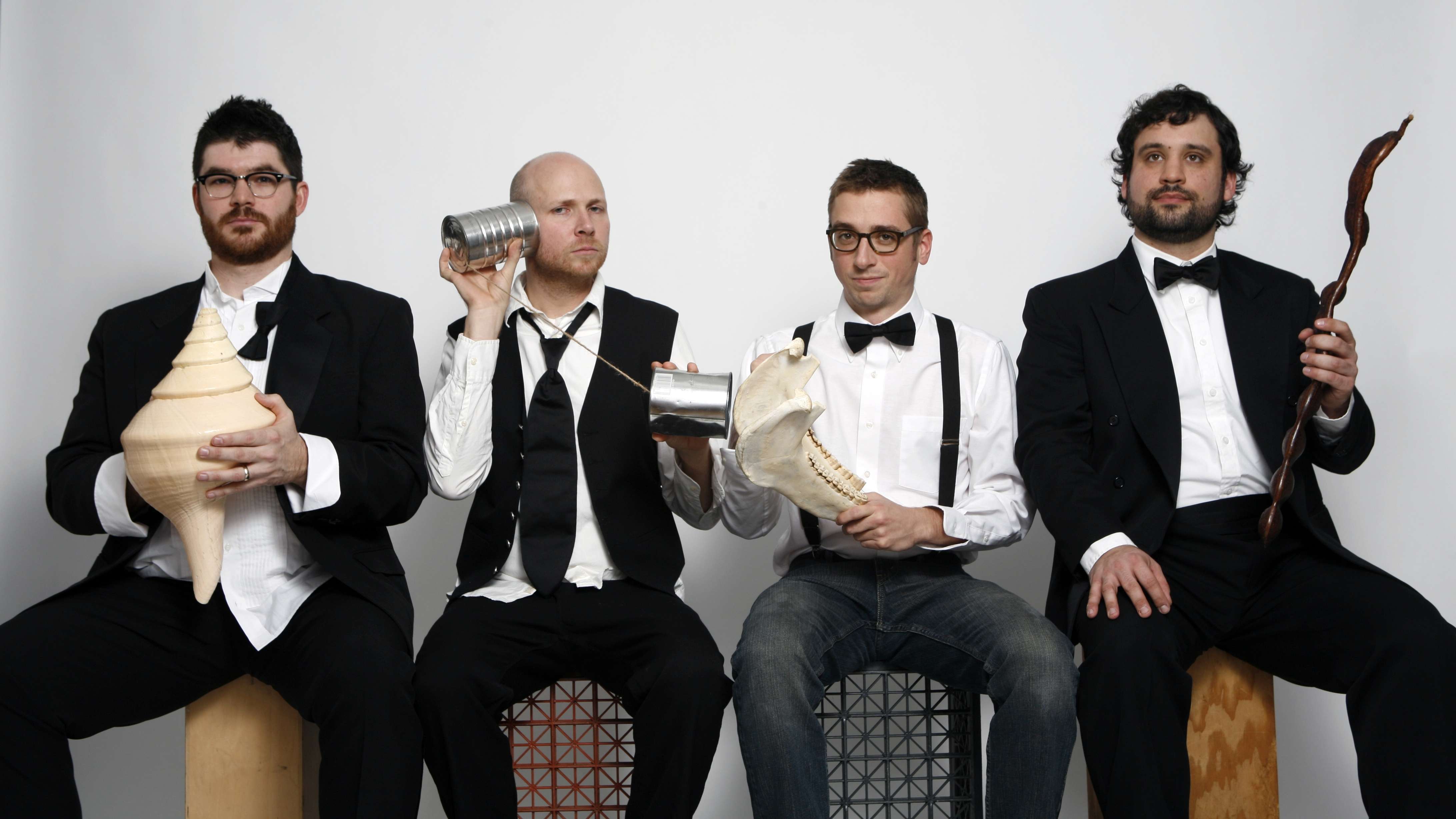|
Back
Works by and inspired by John Cage Toronto
Koerner Hall
03/03/2012 -
John Cage: Credo in US – Imaginary Landscape #1 –
Quartet for Percussion from She is Asleep – Inlets (Improvisation II) – 0'0" (4'33" No. 2) – Duet for Cymbal – 45' for a Speaker – Third Construction
Dan Deacon: Take a Deep Breath
Bottle from Ghostbuster Cook: Origin of the Riddler
Nicole Lizée: White Label Experiment (for John Cage)
Jason Treuting: 24X24
So Percussion and Matmos: Needles
So Percussion (Eric Beach, Josh Quillen, Adam Silwinski, Jason Treuting) –
Dan Deacon (electronics, direction), Nicole Lizée (turntables), Martin (M. C.) Schmidt (reader, electronics)

So Percussion (© Janette Beckman)
Soundstreams artistic director Lawrence Cherney has had a notable career as an oboist, and back in the 60s and 70s performed with John Cage. The Cage centennial occurs this year, and to celebrate the fact he invited So Percussion along with composers Dan Deacon and Nicole Lizée to create what turned out to be a chaotic mash-up of Cage and Cage-inspired works.
The list of 13 works above gives only a hint of what transpired. Most of the pieces were performed simultaneously with at least one other work. A digital count-down was projected above the platform, starting at 91 minutes, the designated length of the intermissionless performance. Watching the clock was important because at the 36-minute point (i.e., with 36 minutes remaining) the audience (who had been handed detailed instructions) were to begin their performance of Dan Deacon’s Take a Deep Breath, a work that lasted precisely 22 and a half minutes.
We first heard Cage’s 1942 work, Credo in US. It was originally staged with dancer Merce Cunningham, and intended as a satire on middle class dysfunction (an eternal target) and wartime jingoism. The notes point out that no two performances can ever be exactly alike - and indeed this time it was Canadianized, beginning with a recording of the final strains of “O Canada”. “O Come all ye Faithful” and “I wonder what’s become of Sally” were other recognizable parts of the musical collage.
Next up: Needles, a composition from 2010 devised by So Percussion and Matmos, a two man electronic band, one half of which was also the evening’s reader, Martin (M.C.) Schmidt. The title refers to the amplified cactus whose needles are plucked; the result can best be described as nighttime sounds in a scary jungle.
This was followed by Cage’s Imaginary Landscape #1 composed in 1939 for percussion and turntables, and is very much a pioneering work of its type. It includes shrieking, repeated, ascending and descending glissandi, the conclusion of which came as a huge relief.
This is where things got complicated. Not only were pieces played out of the order listed in the program, but pieces began to be performed simultaneously. The world premiere if Nicole Lizée’s White Label Experiment (for John Cage), for percussion and turntables entered the melee. Ms Lizée certainly kept herself busy at the turntables but much of the time it was hard to discern just what she was contributing. As the 45-minute mark of the program arrived, Mr.Schmidt began his performance of Cage’s 1954 work 45' for a Speaker, a 45-minute reading from an assemblage of his writings on music. This went on continuously until the end of the concert.
At the 36-minute mark, the lights went up so the audience could read the three pages of instructions and Take a Deep Breath commenced. We were instructed to breathe certain ways,
make specific sounds, use our cell phones set on speakerphone to call someone up and persuade them to sing something which would then be heard (along with all the other phones). We were also instructed to sing to our neighbours and to change seats back and forth. I noticed a couple of people leaving during the mayhem, but most of the audience participated enthusiastically (what have you got to lose?)
In the meantime, the following were also performed: Cage’s Quartet for Percussion from She is Asleep (1943) consisting of 24 tom-toms played with just the players’ fingers - thus a very quiet piece that most likely would not disrupt anyone’s sleep; and Dan Deacon’s Bottles from Ghostbuster Cook: Origin of the Riddler (2011), which makes use of a battery of amplified soda bottles.
Also performed were three highly conceptual Cage works: Inlets, which uses gurgling sounds of water in a conch shell and other abstruse sounds; 0'0" asks performers to “perform a disciplined action in a situation provided with maximum amplification” - well, there was quite a lot of that. (This piece is subtitled 4'33" No. 2, a reference to Cage’s most famous/notorious work for silent piano.) Also Duet for Cymbal which I suspect really consists of impossible notes in the program.
These were followed by 24X24 by So Percussion member Jason Treuting, composed in 2011 in homage to Cage’s Third Construction (1941); both pieces consist of 24 sections each with 24 measures. This was followed by the Cage piece, which requires tin cans and cowbells amongst a host of clangorous instruments. These two pieces and the earlier quartet demand a good deal of co-ordination from the performers - they aren’t just a lot of random noise as some would have you believe.
Speaking of co-ordination: the instrumental pieces and Mr. Schmidt’s reading ended precisely together at precisely the timed finish point of the concert leading one to suspect that the apparent mayhem was really tightly controlled all along.
The raucous party atmosphere continued in the lobby afterward.
For all the John Cage fanatics: So Percussion and friends will be performing programs similar to this over the coming weeks, culminating in an appearance at New York’s Zankel Hall (March 27) which will see the launch of a recording (limited edition - just 300 copies to be released) made from this and other appearances. See www.sopercussion.com for details.
Michael Johnson
|